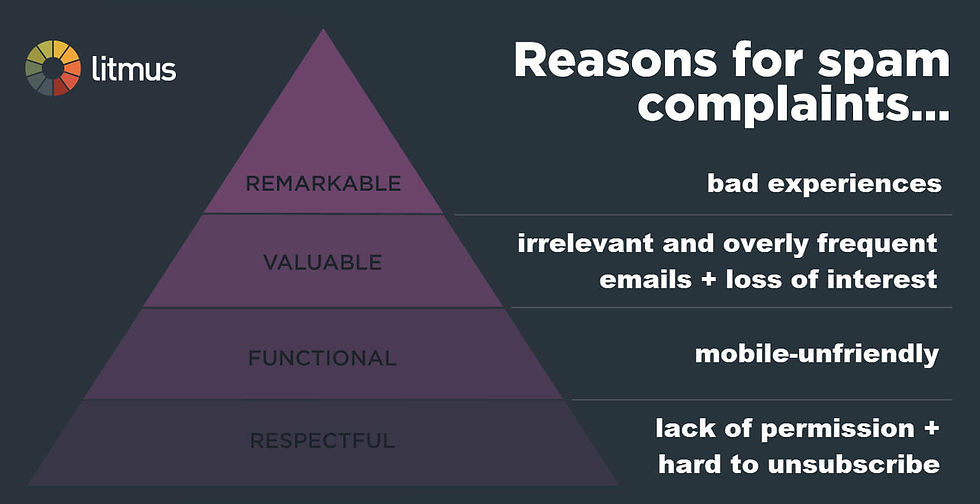The hierarchy of subscriber needs: Key success & failure metrics
- Fahad H

- Nov 1, 2016
- 3 min read
Subscriber expectations have grown steadily over the years, driven higher by a wide range of factors, including the adoption of smartphones, the increase in targeting and the rise in omnichannel experiences.
For email marketers to be successful, they must meet or exceed these expectations, which can be measured by a set of success metrics and a set of failure metrics.
We’ve summarized these demands in the “Hierarchy of Subscriber Needs,” which I’ve outlined below:

Respectful email experiences
Respectful experiences are the foundation of all email relationships. You want to have solid permission practices tailored to each of your email acquisition sources. You also want to set the appropriate expectations for how many emails the subscriber will receive and what content will be in those emails.
The key success metric for respectful email experiences is high open rates.
Functional email experiences
The next level up is functional experiences, a goal that is particularly difficult in the complex world of email marketing. The basics here include having error-free messaging, images and links, but there are many more layers beyond that.
For instance, since there are no coding standards for email, support varies widely across email clients and can change without notice, so previewing every email you send is highly recommended. The range of devices that can display emails can also seriously impact how your email functions, which is why responsive has become the dominant email design approach.
The device used can also impact the post-click landing page experience. Subscribers expect good website experiences and mobile app experiences to follow after they click through an email.
The key success metric for functional email experiences is high click rates.
Valuable email experiences
The third level is valuable experiences. This is where personalization, dynamic content, predictive intelligence, segmentation and marketing automation shine. Marketers create value when they get the right content to the right subscribers at the right time — provided they’re also creating respectful and functional experiences.
The key success metrics for valuable email experiences are high email conversion rates and revenue.
Remarkable email experiences
And the top level is remarkable experiences. People are social beings, with an innate desire to share. When you create share-worthy content, deals and experiences — especially ones that span multiple channels — then you’re fostering brand evangelism and know that you’re fulfilling your subscribers’ highest-level need.
The key success metrics for remarkable email experiences are high forward rates and social share rates.
The key failure metrics
If you fail to meet any of those subscriber needs, you not only perform poorly on those key success metrics, but you also invite high spam complaint and unsubscribe rates. While you might think these two metrics are punishment for creating email experiences that aren’t respectful, that’s not entirely the case.
If a subscriber opts out or complains very early in the relationship, then, yes, that most likely indicates a problem with your permissioning or expectation setting. However, if those happen a bit later in the relationship, they probably indicate issues further up the hierarchy.
That was one the key findings of our “Adapting to Consumers’ New Definition of Spam” report (email registration required), research that we did jointly with people-based digital marketing and consumer acquisition company Fluent. For instance, regarding Functional experiences, 43 percent of respondents said they’d marked a brand’s emails as spam because the emails didn’t display or work well on the subscriber’s smartphone.
Regarding valuable experiences, 57 percent said they’d marked a brand’s emails as spam because the brand sent irrelevant or too many emails. And 53 percent said they’d done so because they were no longer interested in the brand.
Regarding remarkable experiences, 43 percent said they’d marked a brand’s emails as spam because they’d had a bad customer service experience with the brand. That’s also compelling evidence that consumers expect coherent end-to-end experiences and don’t think of brands in terms of silos or channels.

It used to be that spam complaints were a clear and strong indicator of permission problems. However, over time, subscribers have used the “report spam” button to express their displeasure over an ever-wider range of issues — from poor email rendering or difficult landing page experiences to bad customer service experiences.
Now marketers need to take a big-picture perspective on spam complaints and spend more time doing some detective work to determine the causes. While poor permissioning is still a major culprit of complaints, subscribers’ liberal use of the “report spam” button means that the source of some of your complaints may actually have little to do with your email program.








Comments